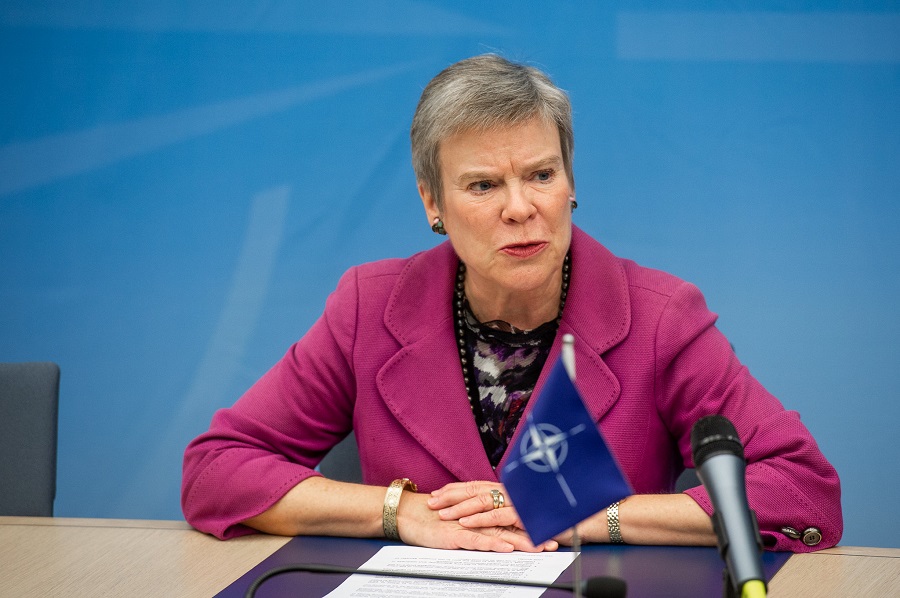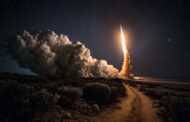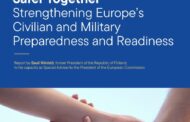NATO Nuclear Policy in a Post-INF World
Speech by NATO Deputy Secretary General Rose Gottemoeller at the University of Oslo
09 Sep. 2019
_____________________________________________________________________________________________________________________________________
Rose Gottemoeller [NATO Deputy Secretary General]: This is a beautiful room, I was just told the Ph.D candidates have to defend in this room, and it would be a bit . . . a bit overwhelming, I think, and it’s certainly a beautiful space, and it’s an honour and pleasure to be here this afternoon to speak to the Oslo Nuclear Forum, and in fact be the inaugural speaker. It’s an enormous pleasure and honour, so thank you very much for the invitation, and look forward to our conversation today. I will follow, if you’ve had a chance to glance at this, I’ll follow the list of questions that were laid out there, but I’ll repeat them, so in case you don’t have them in front of you, you will remember.
The first question I’m going to start on is: what role do you nuclear weapons play in NATO policy? And right off the bat I will say that I am indebted to my colleague, Jessica Cox, who’s the Director of NATO’s Nuclear Policy Directorate and these comments are drawn from the comments she made; but any errors of fact or judgment are strictly my own.
The very first NATO Strategic Concept in 1949 stated the requirement to ensure the ability to carry out strategic bombing promptly, by all means possible, with all types of weapons, without exception. I think this is an excellent early expression of where nuclear weapons fit into NATO policy. They are part of the spectrum of deterrence, including conventional weapons, to defend in three domains: air, sea, land. And in modern times we’ve added cyber and hybrid responses as well.
But they would never be reached for in a routine manner. Nuclear weapons would never be reached for in a routine manner. NATO allies have also been clear that nuclear weapons are unique. They are unique. And the circumstances in which NATO might contemplate the use of nuclear weapons are extremely remote. That is why NATO maintains full political control over nuclear decision-making and the United States maintains full custody of its nuclear weapons forward deployed in Europe.
The fundamental purpose of NATO’s nuclear capability is to preserve peace, prevent coercion and deter aggression. If the fundamental security of any of NATO’s members were to be threatened, NATO has the capabilities and resolve to impose costs on an adversary that would be unacceptable and far outweigh the benefits that that adversary would hope to achieve.
At the 2018 NATO Summit in Brussels, Heads of State and Government once again affirmed NATO’s long standing commitment to nuclear deterrence, stating that as long as nuclear weapons exist, NATO will remain a nuclear Alliance. None of this will change in a post-INF world, so the title of this talk may be a bit misleading. But other factors may affect, which I’ll go into in a moment…..
On arrangements for the US weapons stored on the territory of certain Allies in Europe. I will stress once again that the US maintains full custody, and the arrangements were codified by the United States and the Soviet Union prior to the signing of the Non-Proliferation Treaty in 1968. It is for that reason that nowadays I am impatient about the complaints we hear from Russia about nuclear sharing arrangements violating the Non-Proliferation Treaty. They were agreed and agreed in writing in 1968 with the Soviet government, so there is no cause for complaint.
To support the US nuclear weapons forward deployed in Europe, the Allies provide capabilities and infrastructure; dual-capable aircraft are central to this effort, but supporting contributions are also important and allow a larger number of Allies to participate in the nuclear burden-sharing arrangements. An excellent example of this are the so-called SNOWCAT Missions, in which allied fighters escort dual-capable aircraft if called on for a nuclear mission. NATO is seeking, always, the broadest possible cooperation and participation in the agreed nuclear burden-sharing arrangements.
In addition to the theatre weapons in Europe, which are small in number, the strategic forces of the United States also play a role. They are the supreme guarantee of the security of the Alliance. The independent strategic nuclear forces of the United Kingdom and France have a deterrent role of their own and contribute significantly to the overall security of the Alliance. These Allies’ separate centres of decision-making contribute to deterrence by complicating the potential adversaries’ calculations. Should an adversary decide to attack NATO, they must not only contend with NATO’s decision-making processes, but also the decision-making processes in Washington, London and Paris. So we do believe that this is an important contributor to any attempt to make a calculation regarding use of nuclear weapons.
How might emerging and future threats affect the role of nuclear weapons? This was the second question I was asked to take on. I would like to tackle this question by considering the impact that emerging technologies and their applications might have. I’m going to use the example of cyber technology. Clearly, cyber technology is not an emerging technology, it’s been with us for some time, but it is in a constant state of evolution and sometimes these evolutions are fast-moving and somewhat unpredictable. The advent of quantum computing is widely expected to disrupt how we sustain the security and secrecy of communications, among other impacts.
Indeed, already today we are faced with the possibility that nuclear command and control systems might come under cyber-attack, disrupting our nuclear decision-making in a crisis. Quantum computing, it is feared, will make it even harder to sustain reliable nuclear command and control. So what might the effect be on the NATO nuclear deterrent? I often hear it said that technological disruption of the kind that I’ve described will lead to early nuclear use, a kind of ‘use it or lose it’ scenario. I have even heard some thinking trending in the direction of a so-called ‘dead hand’, that if nuclear command and control connectivity fails, automatic systems should take over and ensure that a nuclear launch occurs.
The Soviets toyed with such a system during the Cold War, which has been well-documented by Bruce Blair and by others, including by Russian experts. For NATO, I simply do not see the possibility of this outcome for two reasons, and they were both referred to in my opening remarks. First, Allies have been clear, unequivocally clear, that nuclear weapons are unique and the circumstances under which NATO might contemplate the use of nuclear weapons are extremely remote. Second, on the spectrum of deterrence, NATO has numerous tools in its toolkit, any of which may be considered to respond to an advanced cyber-attack. If the fundamental security of any of NATO’s members were to be threatened, NATO has the capabilities and the resolve to impose costs on an adversary that would be unacceptable and far outweigh the benefit that any adversary could contemplate achieving.
I should also stress that all NATO nuclear decision-making is done at the political level, through the Nuclear Planning Group. NATO does not delegate any decision about the use or employment of nuclear capabilities to our military commanders. Absolutely no delegation to commanders in the field. But we will have to do everything we can to ensure that, should nuclear weapons be called upon in a conflict, they will be available, no matter how advanced and complex the technological threats become. Here, NATO will place the emphasis on ensuring the resilience of our nuclear forces, their ability to maintain readiness no matter what challenges occur. Some measures may be simple and well-honed by experience, such as dispersing aircraft during a crisis. Others may be more difficult and require NATO always to stay at the leading edge of technology development, such as ensuring that we have technology available to secure and defend the reliability of our communications networks. Another approach will be to provide for redundancy, for example in command and control systems.
NATO will do what it takes to ensure the availability of every tool in its deterrence toolkit and that goes for nuclear weapons as well as other types of weapons and response capabilities. And here I want to emphasise a simple, maybe obvious, point. At NATO we are always talking about response capabilities. That’s the emphasis: response capabilities, because we are a defensive Alliance. We insist on the reliability of all the weapons capabilities available to, us including nuclear weapons, because we want to deter and defend against attacks. Deterrence and defence is what NATO is all about.
Now, let me turn to the third topic which is arms control measures against emerging and future threats. It’s a good thing to remind ourselves that arms control is not a good, in and of itself, but because it contributes to our security, the security of NATO countries. Arms control, disarmament and non-proliferation should complement security and defence. Indeed, it’s my firm view that arms control, disarmament and non-proliferation are part of the continuum of security and defence. With verifiable and reciprocal restraint measures, we can enhance mutual predictability, which is the goal overall of what we are trying to achieve: mutual predictability, so that we can strengthen confidence in our defence capabilities, avoid arms racing and maintain stability.
But the key to success is a firm and shared commitment to reciprocity and verifiability. The value of arms control measures dissipates if one party abandons that commitment. So with the demise of the INF, that is the Intermediate Range Nuclear Forces Treaty, on precisely that basis, the Russians abandoned their commitments to the treaty, where do we go from here? We all acknowledge that this moment is an extraordinarily difficult one for classic arms control, at least as we have known it from the early 1970s through the entry into force of the New START Treaty in February of 2011. But even as we entered into negotiation of New START in 2009, I thought that we were way too stuck in the past, not attempting to take into account the benefits accruing from the information revolution. Those who are engaged in non-military control procedures, such as preventing the smuggling of natural resources or endangered species, have already long been using digitised monitoring, control and record keeping. Why are arms control inspectors stuck with using rulers and pads of paper and, you know, yardsticks, measuring devices?
Why do they have to leave their laptops at home when they go on inspections? Partly, because that’s the way it has always been done. But also there are legitimate security concerns about digital recording that would have to, and will have to, be addressed in any arms control negotiation in the future. So that is part of the problem. But mostly I think it was because the difficulties of negotiating new verification measures seemed daunting and that’s certainly, I think, how it looked to us in 2009. And, to be fair, there are now well-established verification and inspection procedures developed since, really, the earliest strategic arms limitation treaties of the early 70s, but now extended into the onsite inspection regimes, beginning with the Intermediate Range Nuclear Forces Treaty, but also the Strategic Arms Reduction Treaty, START 1. These were some very important procedures laid down early on. So I think about this moment, as difficult as it is, as a time to truly consider what we might be able to accomplish in future arms control agreements.
It’s a moment of historic transition and we should open our minds and take full advantage of it. I’m rather optimistic and I will tell you why. First, problems that we thought were insurmountable 30 years ago are now amenable to resolution. The prime example here is monitoring of warheads on delivery vehicles. When the Intermediate Range Nuclear Forces Treaty, INF, entered into force, it banned all . . . all ground launched intermediate range missiles, conventional and nuclear, because we could not distinguish nuclear from conventional warheads on the front end of missiles. Today, we are in a much better position, both technically and in policy terms, to do so, with the re-entry vehicle onsite inspection regime of the New START Treaty being an early foray into this type of inspection regime.
So already, for almost 10 years, we have been doing re-entry vehicle onsite inspection in the new START verification regime that helps us get at the question of: does the front end of this missile have any nuclear objects on it or not? I have no doubt if we undertook the effort to negotiate a new INF Treaty today, including China and maybe other countries, we could institute a ban on nuclear only ground-launched intermediate range missiles. That is what I call, ‘Putting the N back in INF’ – it’s a little bit ironic, but when INF entered into force in the late 80s it was called the INF Treaty but actually it banned all missiles, whether nuclear or conventional, of this ground-launched intermediate range. So now I talk about, ‘Putting the N back in INF’, thinking about banning only nuclear-armed missiles of a ground-launched sort, in the intermediate ranges.
Alternatively, we could even impose a limit, although that inspection regime would be more challenging than for a ban. It’s always more complicated to figure out how you verify a limit than a ban, where no such missiles are allowed. Concepts, second point. Concepts that have been tried and proven over 40-plus years of arms control regimes are still available to us and we should not think we have to throw everything out and reinvent the wheel at this moment. A fine example here is the concept of freedom to mix, wherein a party to an arms control treaty is given the opportunity to decide just how many weapons systems of a certain type he wants to deploy within a certain negotiated ceiling, choosing not to deploy other weapons.
Looking to the future, one might consider whether controls on hypersonic glide vehicles might be incorporated into a ‘freedom to mix’ approach. If the Russian launch vehicles are existing types of intercontinental ballistic missiles, for example, then Russia would have to decide what normal ICBMs it wanted to continue to deploy under a treaty like the New START Treaty and what number of hypersonic glide vehicles it would want to deploy.
So it would have freedom to mix within the overall limit, but it would have to decide and make some choices about traditional ICBMs arms versus HGVs or hypersonic glide vehicles. The same goes, by the way, for several of the new kinds of nuclear systems that President Putin advertised in March of 2018. If they would be brought into the constraints of New START through the new kind provision of the treaty and we thought ahead about how to bring new kinds into the treaty, then the Russians would have to decide what part of their established arsenal would be cut back to make room for these new, more exotic systems.
Third and final point. I would make the case that we need to take a good, hard look at the information revolution and what it has done for monitoring and sensing. Already, much is being done with commercial satellite imagery. And the good example of this is what has been done with commercial satellite imagery to keep track of the DPRK, the North Korean missile tests. We are all concerned today about ubiquitous sensing, what could be done to deprive us of our privacy, our free movement rights, free association and free expression.
At the same time, I’ve been arguing for a number of years now that ubiquitous sensing, properly regulated and designed into arms control treaties and agreements can improve our verification capabilities. The ideas are controversial, but some of them are already in play. For example, the notion of engaging citizen volunteers is widely used today in environmental monitoring; and Japanese citizen volunteers improve the radiation detection in range of the Fukushima power plant by making use of an app on their mobile phones. If we are all worried about strengthening the ban on chemical weapons use, should we not be empowering those who live with the threat of chlorine attacks to be able to report rapidly and accurately, and also confidentially, when they occur?
This might be done through dispersed sensing mechanisms. I think these kinds of ideas are worth debating. Not every measure or every treaty would it be appropriate to have citizen volunteers involved. But I think, nevertheless, that in certain settings it could be quite useful to draw them in. And, in certain settings, indeed, dispersed sensing mechanisms on a number of mobile platforms could make a difference to how we understand deployment patterns in the future.
Thus, I will end on a hopeful note. I grasp that we are in a difficult moment with arms control treaties and agreements, but I think we should regard the moment as one of opportunity, to look to the future and consider what we should be doing differently to improve the verifiability of future treaties. We’ve had enough problems with non-compliance that the Reaganesque adage of ‘trust but verify’ needs to be embraced anew, now as never before. And many of your countries have already been involved in important efforts.
I would say that Norway has been particularly active, from over a decade ago, in looking at new methods of nuclear warhead verification, the famous experiment that was run between Norway and the UK on looking at nuclear warhead verification. But there also have been important activities going on, such as the International Partnership for Nuclear Disarmament Verification, the IPNDV, the Quadripartite exercise, that is expanding on the UK-Norway experiment. We have a lot of interesting work going on and, hopefully, in a way that also can engage and involve you, who are younger experts. We’ve got a running start now in tackling these problems, so I think we just need to get on with it and to prepare for the future.
So, thank you very much for your attention. I look forward to our question and answer period and having an opportunity for hearing from you as well and for some informal exchange. So, thank you very much indeed.
* * * * *
Zdroj: https://www.nato.int/cps/en/natohq/opinions_168602.htm
Ilustračné foto: https://www.flickr.com/photos/nato/44180358535/







